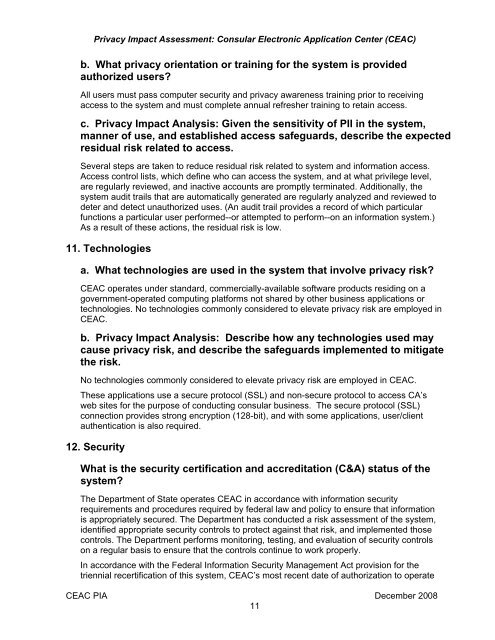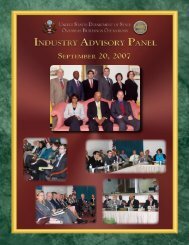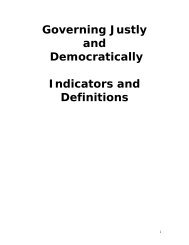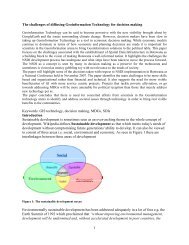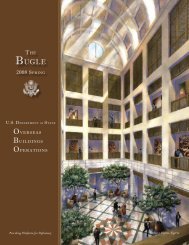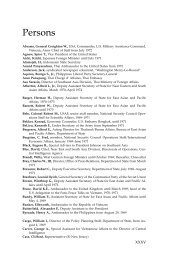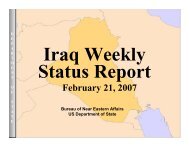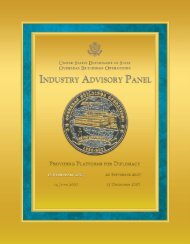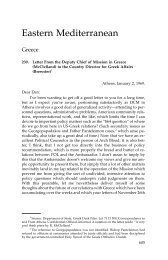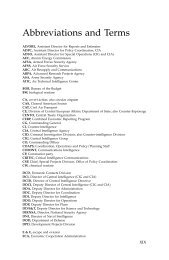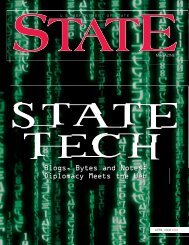Consular Electronic Application Center (CEAC) - US Department of ...
Consular Electronic Application Center (CEAC) - US Department of ...
Consular Electronic Application Center (CEAC) - US Department of ...
You also want an ePaper? Increase the reach of your titles
YUMPU automatically turns print PDFs into web optimized ePapers that Google loves.
Privacy Impact Assessment: <strong>Consular</strong> <strong>Electronic</strong> <strong>Application</strong> <strong>Center</strong> (<strong>CEAC</strong>)<br />
b. What privacy orientation or training for the system is provided<br />
authorized users?<br />
All users must pass computer security and privacy awareness training prior to receiving<br />
access to the system and must complete annual refresher training to retain access.<br />
c. Privacy Impact Analysis: Given the sensitivity <strong>of</strong> PII in the system,<br />
manner <strong>of</strong> use, and established access safeguards, describe the expected<br />
residual risk related to access.<br />
Several steps are taken to reduce residual risk related to system and information access.<br />
Access control lists, which define who can access the system, and at what privilege level,<br />
are regularly reviewed, and inactive accounts are promptly terminated. Additionally, the<br />
system audit trails that are automatically generated are regularly analyzed and reviewed to<br />
deter and detect unauthorized uses. (An audit trail provides a record <strong>of</strong> which particular<br />
functions a particular user performed--or attempted to perform--on an information system.)<br />
As a result <strong>of</strong> these actions, the residual risk is low.<br />
11. Technologies<br />
a. What technologies are used in the system that involve privacy risk?<br />
<strong>CEAC</strong> operates under standard, commercially-available s<strong>of</strong>tware products residing on a<br />
government-operated computing platforms not shared by other business applications or<br />
technologies. No technologies commonly considered to elevate privacy risk are employed in<br />
<strong>CEAC</strong>.<br />
b. Privacy Impact Analysis: Describe how any technologies used may<br />
cause privacy risk, and describe the safeguards implemented to mitigate<br />
the risk.<br />
No technologies commonly considered to elevate privacy risk are employed in <strong>CEAC</strong>.<br />
These applications use a secure protocol (SSL) and non-secure protocol to access CA’s<br />
web sites for the purpose <strong>of</strong> conducting consular business. The secure protocol (SSL)<br />
connection provides strong encryption (128-bit), and with some applications, user/client<br />
authentication is also required.<br />
12. Security<br />
What is the security certification and accreditation (C&A) status <strong>of</strong> the<br />
system?<br />
The <strong>Department</strong> <strong>of</strong> State operates <strong>CEAC</strong> in accordance with information security<br />
requirements and procedures required by federal law and policy to ensure that information<br />
is appropriately secured. The <strong>Department</strong> has conducted a risk assessment <strong>of</strong> the system,<br />
identified appropriate security controls to protect against that risk, and implemented those<br />
controls. The <strong>Department</strong> performs monitoring, testing, and evaluation <strong>of</strong> security controls<br />
on a regular basis to ensure that the controls continue to work properly.<br />
In accordance with the Federal Information Security Management Act provision for the<br />
triennial recertification <strong>of</strong> this system, <strong>CEAC</strong>’s most recent date <strong>of</strong> authorization to operate<br />
<strong>CEAC</strong> PIA December 2008<br />
11


